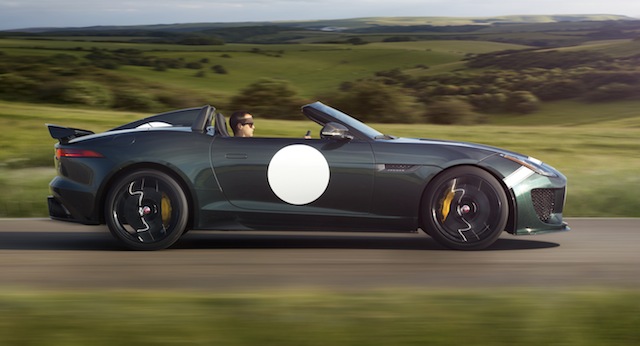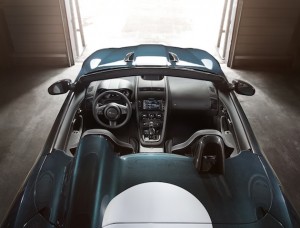
The Jaguar F-Type Project 7 went from a sketch to a race-ready car in only four months – and now it is going into production as a road-ready limited-edition, with a production run of 250.
Based on the F-Type, the two-seater design was inspired by the race-winning D-Type of the 1950s, complete with the hump-like rear faring behind the driver. The passenger wring is abbreviated. Indeed, the number “7” refers to the seven wins Jaguar clocked up in the Le Mans 24-hour race.

Project 7 began early last year as a sketch of an F-Type single-seater by Jaguar designer Cesar Pieri. He showed it to design director Ian Callum, who liked what he saw. “As designers, our very purpose is to disrupt – to turn the norm on its head and see if it still works – and here at Jaguar, we love to push the boundaries,” said Callum.
“As a team our challenge was to take this gem of an idea, work within the limitations of production feasibility, and create something worthwhile.
“So I encouraged Cesar and Alister Whelan (Jaguar’s chief designer) to take it to the next stage and develop a workable concept, and with the support of key departments across the business, Project 7 was born.”

The single-seat, open-topped sports car, with a lowered windscreen and D-Type design elements, was revealed at the Goodwood Festival of Speed this time last year. It was greeted with such enthusiasm that Jaguar decided to build a production version, with a few changes here and there to meet road rules. Jaguar’s Special Vehicle Operations (SVO) team did the rest.
The most obvious change of course is that it is now a two-seater, handmade and with an aluminium body. The windscreen has been further lowered by 114mm for a total height of 30.5mm and other modifications include a front splitter made from plastic and carbon-fibre, carbon-fibre side skirts. The car’s rear diffuser and adjustable rear spoiler increase downforce over the F-Type by 177 per cent.
The use of carbon fibre elsewhere has helped to pull down Project 7’s weight to 1585kg, 80kg lighter than the F-Type. The racing-inspired sports seats get optional four-point harnesses and a numbered plaque signed by Ian Callum sits between the seats.

Under the bonnet is the same 5.0-litre supercharged V8 found in the regular F-Type, only Project 7’s delivers 19kW more power for a total output of 423kW, while torque remains the same at 680Nm. Power goes to the rear wheels via a revised version of the F-Type’s ZF eight-speed automatic gearbox. “The Project 7 is already faster than the F-Type Coupe R on the track,” said SVO chief Paul Newson. “We expect it to be the fastest Jaguar ever around the Nurburgring, a lap time will come later.”
Spring and damper settings are 50 per cent stiffer at the front and 8 per cent stiffer at the rear than a F-Type V8 S Roadster, while it gets torque vectoring and adaptive dampers. Carbon-ceramic brakes are standard and a degree of negative camber has been added to the front wheels to make turn in even sharper.
Project 7 rides on 20-inch alloy wheels shod with Continental ForceContact tyres (255/35/20 up front and 295/30/20 at the rear) and ceramic brakes. Jaguar claims a 0-100km/h time of 3.9 seconds and an electronically limited top speed of 300km/h. It will be offered in five metallic colours: blue, red, green, black and white, each one costing around the equivalent of $NZ270,000.



